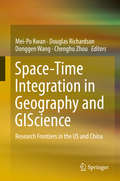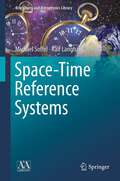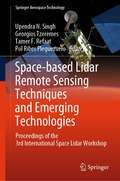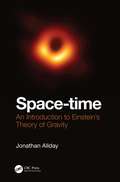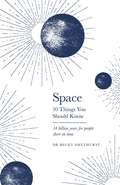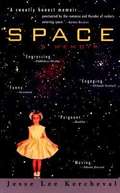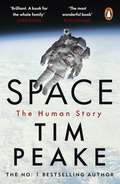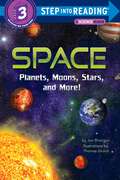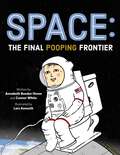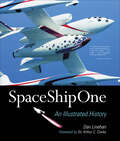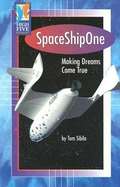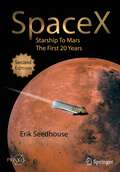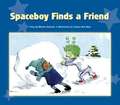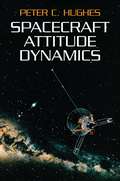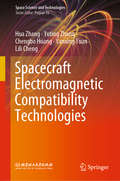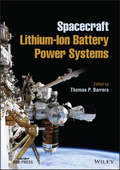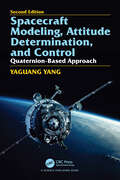- Table View
- List View
Space-Time Foliation in Quantum Gravity
by Yuki SatoIn this thesis, the author considers quantum gravity to investigate the mysterious origin of our universe and its mechanisms. He and his collaborators have greatly improved the analyticity of two models: causal dynamical triangulations (CDT) and n-DBI gravity, with the space-time foliation which is one common factor shared by these two separate models. In the first part, the analytic method of coupling matters to CDT in 2-dimensional toy models is proposed to uncover the underlying mechanisms of the universe and to remove ambiguities remaining in CDT. As a result, the wave function of the 2-dimensional universe where matters are coupled is derived. The behavior of the wave function reveals that the Hausdorff dimension can be changed when the matter is non-unitary. In the second part, the n-DBI gravity model is considered. The author mainly investigates two effects driven by the space-time foliation: the appearance of a new conserved charge in black holes and an extra scalar mode of the graviton. The former implies a breakdown of the black-hole uniqueness theorem while the latter does not show any pathological behavior.
Space-Time Integration in Geography and GIScience
by Donggen Wang Chenghu Zhou Mei-Po Kwan Douglas RichardsonSpace-time analysis is a rapidly growing research frontier in geography, GIS, and GIScience. Advances in integrated GPS/GIS technologies, the availability of large datasets (over time and space), and increased capacity to manage, integrate, model and visualize complex data in (near) real time, offer the GIS and geography communities extraordinary opportunities to begin to integrate sophisticated space-time analysis and models in the study of complex environmental and social systems, from climate change to infectious disease transmission. This volume specifically focuses on research frontiers, comparative research, and research and application interactions in this field in the US and China, arguably the two most dynamic loci for this work today. The contributions to this book, by top researchers in China and the US, productively highlight the differences and similarities in approaches and directions for space-time analysis in the two countries. In light of the recent rapid progress in GIScience research on space-time integration in both countries, the book's focus on research frontiers in these two countries will attract great interest in both countries and in other parts of the world as well as among related disciplines. In addition, the book also explores the impact of collaborative research and publications underway in this area between the US and China and will provide an overview of these collaborative efforts and programs. This book will not only be of interest to university-based GIS researchers and students, but also to those interested in this new area of research and applications like researchers and developers in business, internet mapping and GIS and location based services (LBS).
Space-Time Reference Systems
by Michael Soffel Ralf LanghansThe high accuracy of modern astronomical spatial-temporal reference systems has made them considerably complex. This book offers a comprehensive overview of such systems. It begins with a discussion of 'The Problem of Time', including recent developments in the art of clock making (e.g., optical clocks) and various time scales. The authors address the definitions and realization of spatial coordinates by reference to remote celestial objects such as quasars. After an extensive treatment of classical equinox-based coordinates, new paradigms for setting up a celestial reference system are introduced that no longer refer to the translational and rotational motion of the Earth. The role of relativity in the definition and realization of such systems is clarified. The topics presented in this book are complemented by exercises (with solutions). The authors offer a series of files, written in Maple, a standard computer algebra system, to help readers get a feel for the various models and orders of magnitude. Beyond astrometry, the main fields of application of high-precision astronomical spatial-temporal reference systems and frames are navigation (GPS, interplanetary spacecraft navigation) and global geodynamics, which provide a high-precision Celestial Reference System and its link to any terrestrial spatial-temporal reference system. Mankind's urgent environmental questions can only be answered in the context of appropriate reference systems in which both aspects, space and time, are realized with a sufficiently high level of accuracy. This book addresses all those interested in high-precision reference systems and the various techniques (GPS, Very Long Baseline Interferometry, Satellite Laser Ranging, Lunar Laser Ranging) necessary for their realization, including the production and dissemination of time signals.
Space-Time Structure
by Erwin SchrödingerReprint of a classical book first published in 1950. This lucid and profound exposition of Einstein's 1915 theory of gravitation is essential reading.
Space-based Lidar Remote Sensing Techniques and Emerging Technologies: Proceedings of the 3rd International Space Lidar Workshop (Springer Aerospace Technology)
by Upendra N. Singh Georgios Tzeremes Tamer F. Refaat Pol Ribes PleguezueloThis book gathers the latest advances, innovations, and applications in the field of space lidar missions, techniques, and technologies, as presented at the 3rd International Workshop on Space-Based Lidar Remote Sensing Techniques and Emerging Technologies (LIDAR), held in Milos Island, Greece, on June 18–23, 2023. It covers highly diverse topics such as space-based lidar techniques and methodologies; challenges experienced in space lidar missions; planning of new space earth observation lidar missions, including monitoring of topography, cryosphere, biomass, greenhouse and trace gases clouds, aerosols; exploration lidars, including entry, decent and precision landing, as well as hazard avoidance for Mars & Lunar landers missions; results and plans for simulations, airborne experiments and demonstrations as precursors for space missions; emerging space lidar technologies, particularly in lasers, optics, electronics and detectors as well as space lidar reliability and influencing factors, such as effects of the space environment. Written by leading scientists and technologists from government agencies, industries and universities, and selected by means of a rigorous international peer-review process, the contributions highlight numerous exciting ideas that will spur novel research directions and foster multidisciplinary collaborations.
Space-time: An Introduction to Einstein's Theory of Gravity
by Jonathan AlldayThis book, suitable for interested post-16 school pupils or undergraduates looking for a supplement to their course text, develops our modern view of space-time and its implications in the theories of gravity and cosmology. While aspects of this topic are inevitably abstract, the book seeks to ground thinking in observational and experimental evidence where possible. In addition, some of Einstein’s philosophical thoughts are explored and contrasted with our modern views. Written in an accessible yet rigorous style, Jonathan Allday, a highly accomplished writer, brings his trademark clarity and engagement to these fascinating subjects, which underpin so much of modern physics. Features: Restricted use of advanced mathematics, making the book suitable for post-16 students and undergraduates Contains discussions of key modern developments in quantum gravity, and the latest developments in the field, including results from the Laser Interferometer Gravitational-Wave Observatory (LIGO) Accompanied by appendices on the CRC Press website featuring detailed mathematical arguments for key derivations
Space: 10 Things You Should Know
by Rebecca Smethurst'Bite-sized, cutting edge science delivered with enormous enthusiasm - all you need to travel the cosmos' CHRIS LINTOTT 'A lot of astrophysics is packed into this neat little book . . . I guarantee you will come away knowing your dark matter from your supermassive black holes' JIM AL-KHALILI This book is for anyone who wants to easily understand the mind-blowing fundamentals of our extraordinary, expanding universe.Written by Oxford astrophysicist Dr Becky Smethurst and composed of ten captivating, simple essays, it guides you swiftly through the galaxies, explaining the mysteries of black holes, dark matter and what existed before the Big Bang, presenting the evidence as to whether we really are alone, illuminating what we still don't know, and much more besides.If you have big questions about Space, this book will provide you with the answers in an engaging and succinct way.
Space: A Memoir
by Jesse Lee KerchevalKercheval remembers her days growing up in Florida, her mother addicted to Valium and her father turning into a workaholic.
Space: A thrilling human history by Britain's beloved astronaut Tim Peake
by Tim PeakeFrom bestselling author and British astronaut Tim Peake, an inspirational human history of space travel, from the Apollo missions to our future forays to Mars. The Right Stuff for a new generation.'This book is brilliant - once in a blue moon. A book for the whole family.' Chris Evans, Virgin Radio'The most wonderful book ... Tim Peake is a historian and encyclopaedia of space.’ Rory Stewart'An extraordinary book. For anyone - even if you’re not interested in Space. If you’re interested in human stories and the human character - this is delightful.' BBC Breakfast'A fascinating, detailed, playful book drawn from extensive research – Peake met seven Apollo astronauts, Russian cosmonauts and various other space technicians – as well as his considerable personal experience. Lifts the lid on what space is like: the dedication and sacrifice; the politics and pantomime; the practicalities and the peril; the glory and fame; the adjustment back to normal life.' iPaper'A thrilling human history of space' Daily Mirror'The bible of space travel' Chris Moyles, Radio XAs seen in the major TV series Secrets of Our Universe with Tim Peake.Only 656 people in human history have left Earth. In Space: The Human Story, astronaut Tim Peake traces the lives of these remarkable men and women who have forged the way, from Yuri Gagarin to Neil Armstrong, from Valentina Tereshkova to Peggy Whitson.Full of exclusive new stories, and astonishing detail only an astronaut would know, the book conveys what space exploration is really like: the wondrous view of Earth, the surreal weightlessness, the extraordinary danger, the surprising humdrum, the unexpected humour, the newfound perspective, the years of training, the psychological pressures, the gruelling physical toll, the thrill of launch and the trepidation of re-entry. The book also examines the surprising, shocking and often poignant stories of astronauts back on Earth, whose lives are forever changed as they readjust to terra firma.Publication of the book comes on the eve of NASA's plans to return to the moon, fifty years after an astronaut last walked on the lunar surface. In 2024 the Artemis II mission will send four astronauts to orbit the moon. In 2025 Artemis III will send the first woman and the first person of colour to step on the lunar surface. What will separate these upcoming moonwalkers from the legendary Apollo crews? Does it still take a daring-do attitude, super-human fitness, intelligence, plus the 'Right-stuff' - a fabled grace under pressure? And how will astronauts travel even further - to Mars and beyond? Space: The Human Story reveals all.
Space: Planets, Moons, Stars, And More! (Step into Reading)
by Joe RhatiganLearn about our solar system in this Step 3 Science Reader packed with NASA photos and space facts! Step into Reading, the most trusted name in early readers, delivers an introduction to the final frontier that kids can read themselves! For up-to-date information (including about Pluto and its fellow dwarf planets) and stellar photos and illustrations, kids eager for mind-blowing nonfiction need look no further! Step 3 Readers feature engaging characters in easy-to-follow plots about popular topics. They are ideal for children who are ready to read on their own.
Space: The Final Pooping Frontier
by Connor White Annabeth Bondor-StoneDiscover the down and dirty scientific history of astronauts pooping in space in this funny and factual picture book.Everybody poops. So, what’s an astronaut to do when hurtling through space with zero gravity and zero privacy? Go boldly.This is a scientific history of pooping in space. From the earliest NASA missions up through the innovative results of their recent Space Poop Challenge design competition, we’ll see the evolution of pooping on the final frontier. With fascinating facts and a few mishaps and discarded technologies along the way, we’ll learn why it’s so hard to deal with waste management in space.
Space: The Next Business Frontier
by H. P. Newquist Lou DobbsFrom the Publisher With the collapse of the dot-com stocks, investors are anxiously considering what sector will provide the next leap forward with spectacular returns. Lou Dobbs, the best-known personality in America in broadcast financial journalism, co-founder of CNNfn and CNN's Moneyline and current twice-weekly on-air commentator for the Today Show and the Infinity Broadcasting Network on radio believes that the answer comes in five letters: SPACE. In Space: The Next Business Frontier, Dobbs and co-author HP Newquist explore where the money will go, which new technologies will emerge as winners, and which corporations and countries will win or lose. Space: The Next Business Frontier is a crucial examination of an industry which may someday dwarf the internet itself.
SpaceShipOne: An Illustrated History
by Dan Linehan“One of the most remarkable accomplishments in our conquest of gravity.” — Sir Arthur C. Clarke In April, 2003, a company called Scaled Composites introduced SpaceShipOne to the world. SpaceShipOne: An Illustrated History chronicles the development of the world’s first commercial manned space program—aprogram that includes an airborne launcher (the White Knight), a space ship (SpaceShipOne), rocket propulsion, avionics, simulator, and full ground support. With ample illustrations, photographs, and behind-the-scenes information, SpaceShipOne provides a full picture of this classified project. The story of SpaceShipOne combines the adventurous spirit of Charles Lindbergh, the entrepreneurial drive of Howard Hughes, and the urgency of the space race at the height of the Cold War.
SpaceShipOne: Making Dreams Come True
by Tom SibilaDescribes the spacecraft known as SpaceShipOne, and explains its adventures into space in 2004.
SpaceX: Starship to Mars – The First 20 Years (Springer Praxis Books)
by Erik SeedhouseLearn about commercial spaceflight’s most successful startup in this fully updated book, which follows the extraordinary feats of engineering and human achievement that have placed SpaceX at the forefront of the launch industry and positioned it as the most likely candidate for transporting humans to Mars. This second edition emphasizes SpaceX's much-hyped manned mission to the Red Planet. With a plethora of new material gathered from 2013 to the present, the text offers the most up-to-date portrait of the maverick band of scientists and engineers producing some of the most spectacular aviation triumphs of the 21st century. Topics covered in this book include: all CRS flights, the challenges of developing retro-propulsion, and the pathway towards realizing the Falcon Heavy and BFR. In addition, the chapters describe SpaceX’s emphasis on simplicity, low-cost, and reliability, and the methods the company employs to reduce its costs while speeding up decision-making and delivery. Detailing the Falcon 1, Falcon 9 and Falcon Heavy launch vehicles, the book shows how SpaceX is able to offer a full spectrum of light, medium, and heavy lift launch capabilities to its customers and how it is able to deliver spacecraft into any inclination and altitude, from low Earth orbit to geosynchronous orbit to planetary missions. This book is the perfect go-to guide on SpaceX for anybody working or interested in the commercial space arena.
Spaceboy Finds a Friend (Spaceboy #Set 1)
by Michele DufresneAfter landing earth, the spaceboy wanted to befriend a man but felt disappointed as he was a snowman. But he was lucky to get a good friend.
Spacecraft Attitude Dynamics
by Peter C. HughesPointing a satellite in the right direction requires an extremely complex system -- one that describes the satellite's orientation and at the same time predicts and either uses or neutralizes external influences.From its roots in classical mechanics and reliance on stability theory to the evolution of practical stabilization ideas, Spacecraft Attitude Dynamics offers comprehensive coverage of environmental torques encountered in space; energy dissipation and its effects on the attitude stability of spinning bodies; motion equation for four archetypical systems derived and used repeatedly throughout the text; orientation parameters (not limited to Euler angles); illustrations of key concepts with on-orbit flight data; and typical engineering hardware, with examples of the implementation of dynamic ideas.Suitable as a text for advanced undergraduates and graduate students, this unified treatment is also a valuable reference for professional engineers studying the analysis and application of modern spacecraft attitude dynamics. The sole prerequisites are a fundamental knowledge of vector dynamics and matrix algebra. Over 250 diagrams appear throughout the text, along with extensive problem sets at the end of each chapter, 350 references (cited, interpreted, and placed in perspective to reinforce the material), and two helpful appendixes.
Spacecraft Dynamics and Control
by Marcel J. SidiUsed increasingly in telecommunications, scientific research, surveillance, and meteorology, satellites rely heavily on complex onboard control systems. This book explains the basic theory of spacecraft dynamics and control and the practical aspects of controlling a satellite. The emphasis is on analyzing and solving real-world engineering problems. Among the topics covered are orbital dynamics, attitude dynamics, gravity gradient stabilization, single and dual spin stabilization, attitude maneuvers, attitude stabilization, and structural dynamics and liquid sloshing.
Spacecraft Electromagnetic Compatibility Technologies (Space Science and Technologies)
by Hua Zhang Yuting Zhang Chengbo Huang Yanxing Yuan Lili ChengThis book explores key techniques and methods in electromagnetic compatibility management, analysis, design, improvement and test verification for spacecraft. The first part introduces the general EMC technology of spacecraft, the electromagnetic interference control method and management of electromagnetic compatibility. The second part discusses the EMC prediction analysis technique and its application in spacecraft, while the third presents the EMC design of spacecraft modules and typical equipment. The final two parts address spacecraft magnetic design testing technologies and spacecraft testing technologies. The book also covers the program control test process, the special power control unit (PCU), electric propulsion, PIM test and multipaction testing for spacecraft, making it a valuable resource for researchers and engineers alike.
Spacecraft Lithium-Ion Battery Power Systems (IEEE Press)
by Thomas P. BarreraSpacecraft Lithium-Ion Battery Power Systems Provides Readers with a Better Understanding of the Requirements, Design, Test, and Safety Engineering of Spacecraft Lithium-ion Battery Power Systems Written by highly experienced spacecraft engineers and scientists working at the forefront of the aerospace industry, Spacecraft Lithium-Ion Battery Power Systems is one of the first books to provide a comprehensive treatment of the broad area of spacecraft lithium-ion battery (LIB) power systems technology. The work emphasizes the technical aspects across the entire lifecycle of spacecraft LIBs including the requirements, design, manufacturing, testing, and safety engineering principles needed to deploy a reliable spacecraft LIB-based electrical power system. A special focus on rechargeable LIB technologies as they apply to unmanned and crewed Earth-orbiting satellites, planetary mission spacecraft (such as orbiters, landers, rovers and probes), launch vehicle, and astronaut spacesuit applications is emphasized. Using a system’s engineering approach, the book bridges knowledge gaps that typically exist between academic and industry practitioners. Key topics of discussion and learning resources include: Detailed systematic technical treatment of spacecraft LIB-based electrical power systems across the entire LIB lifecycle Principles of lithium-ion cell and battery design and test, LIB sizing, battery management systems, electrical power systems, safety engineering, ground and launch-site processing, and on-orbit mission operations Special topics such as requirements engineering, qualification testing, thermal runaway hazards, dead bus events, life cycle testing and prediction analyses, on-orbit LIB power system management, and spacecraft EPS passivation strategies Comprehensive discussion of on-orbit and emerging space applications of LIBs supporting various commercial, civil, and government spacecraft missions such as International Space Station, Galileo, James Webb Telescope, Mars 2020 Perseverance Rover, Europa Clipper, Cubesats, and more Overall, the work provides professionals supporting all aspects of the aerospace marketplace with key knowledge and highly actionable information pertaining to LIBs and their specific applications in modern spacecraft systems.
Spacecraft Maximum Allowable Concentrations for Selected Airborne Contaminants: Volume 3
by Subcommittee on Spacecraft Maximum Allowable ConcentrationsThe National Aeronautics and Space Administration (NASA) has measured numerous airborne contaminants in spacecraft during space missions because of the potential toxicological hazards to humans that might be associated with prolonged spacecraft missions.This volume reviews the spacecraft maximum allowable concentrations (SMACs) for various contaminants to determine whether NASA's recommended exposure limits are consistent with recommendations in the National Research Council's 1992 volume Guidelines for Developing Spacecraft Maximum Allowable Concentrations for Space Station Contaminants.
Spacecraft Maximum Allowable Concentrations for Selected Airborne Contaminants: Volume 3
by Subcommittee on Spacecraft Maximum Allowable ConcentrationsThe National Aeronautics and Space Administration (NASA) has measured numerous airborne contaminants in spacecraft during space missions because of the potential toxicological hazards to humans that might be associated with prolonged spacecraft missions.This volume reviews the spacecraft maximum allowable concentrations (SMACs) for various contaminants to determine whether NASA's recommended exposure limits are consistent with recommendations in the National Research Council's 1992 volume Guidelines for Developing Spacecraft Maximum Allowable Concentrations for Space Station Contaminants.
Spacecraft Maximum Allowable Concentrations for Selected Airborne Contaminants: Volume 4
by National Research CouncilThe National Academies Press (NAP)--publisher for the National Academies--publishes more than 200 books a year offering the most authoritative views, definitive information, and groundbreaking recommendations on a wide range of topics in science, engineering, and health. Our books are unique in that they are authored by the nation's leading experts in every scientific field.
Spacecraft Modeling, Attitude Determination, and Control: Quaternion-Based Approach, Second edition
by Yaguang YangThis book discusses spacecraft attitude control-related topics: spacecraft modeling, spacecraft attitude determination and estimation, and spacecraft attitude controls. Unlike other books addressing these topics, this book focuses on quaternion-based methods because of their many merits. It provides a brief but necessary background on rotation sequence representations and frequently used reference frames that form the foundation of spacecraft attitude description. It then discusses the fundamentals of attitude determination using vector measurements, various efficient (including very recently developed) attitude determination algorithms, and the instruments and methods of popular vector measurements. With available attitude measurements, attitude control designs for inertial point and nadir pointing are presented in terms of required torques which are independent of actuators in use. Given the required control torques, some actuators are not able to generate the accurate control torques; therefore, spacecraft attitude control design methods with achievable torques for these actuators (for example, magnetic torque bars and control moment gyros) are provided. Some rigorous controllability results are provided.The book also includes attitude control in some special maneuvers and systems, such as orbital-raising, docking and rendezvous, and multi-body space systems that are normally not discussed in similar books. All design methods are based on state-spaced modern control approaches, such as linear quadratic optimal control, robust pole assignment control, model predictive control, and gain scheduling control. Applications of these methods to spacecraft attitude control problems are provided. Appendices are provided for readers who are not familiar with these topics.
Spacecraft Operations (Springer Aerospace Technology)
by Thomas Uhlig Florian Sellmaier Michael SchmidhuberThis book describes the basic concepts of spacecraft operations for both manned and unmanned missions. The first part of the book provides a brief overview of the space segment. The next four parts deal with the classic areas of space flight operations: mission operations, communications and infrastructure, the flight dynamics system, and the mission planning system. This is followed by a part describing the operational tasks of the various subsystems of a classical satellite in Earth orbit. The last part describes the special requirements of other mission types due to the presence of astronauts, the approach of a satellite to another target satellite, or leaving Earth orbit in interplanetary missions and landing on other planets and moons.The 2nd edition is published seven years after the first edition. It contains four new chapters on flight procedures, the human factors, ground station operation, and software and systems. In addition, several chapters have been extensively expanded. The entire book has been brought up to date and the language has been revised.This book is based on the “Spacecraft Operations Course” held at the German Space Operations Center. However, the target audience of this book is not only the participants of the course, but also students of technical and scientific courses, as well as technically interested people who want to gain a deeper understanding of spacecraft operations.

